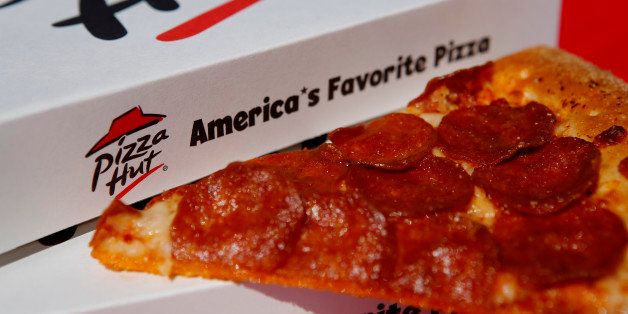
America, we've got a salt problem.
This year, the CDC reported that nine out of 10 kids in the U.S. consume too much salt. This is not because children are latched on to the salt shaker, but rather the foods they most commonly eat (like pizza, burgers, meats and cheeses) are already laden with the stuff. American adults have not grown out of the habit. The FDA recommends the average American consumes no more than 2,300 mg of salt per day, but the average American ingests about 1,000 mg over budget.
It seems limiting our salt consumption may be easier said than done. A recent international survey released by World Action on Salt & Health found that Pizza Hut pizzas in the U.S. contain about 70 percent more salt than the same pizzas in Canada and New Zealand. Because the chain sells different menu items internationally, the survey examined five pizzas that have the most global continuity. Served stateside, the Pepperoni Thin 'N Crispy pizza contains 1,080 milligrams of sodium for every half slice. In Canada, that same half slice contains 718 milligrams of sodium. The salt was measured in milligrams per 3.5 ounce of pizza to eliminate the influence of portion size.
We shouldn't have to cross the border to reduce our sodium intake. "If Pizza Hut can serve less salty pizzas to their customers in Canada and New Zealand, the company should be able to slash salt levels in the American versions of the same -- and all its other -- pizzas," said Michael F. Jacobson, the executive director of the Center for Science in the Public Interest.
The dangers of consuming excess salt run the gamut: obesity, stroke and heart attack are just a few of the risks linked with overdoing it.
It's not just Pizza Hut: A 2012 study published in the Canadian Medical Association Journal revealed that fast food tended to be saltier in the U.S. than in other countries. Why this is seems to be a mystery. As Health.com reports, excess salt is not reflected in consumer demand or local tastes, and the U.S. is not limited in its food-processing technology, meaning sodium could be reduced if more specific guidelines were enforced.
Even more, Pizza Hut slices in the U.S. were reported to be 40 percent larger than in other countries, which means when an American consumer eats a full meal at Pizza Hut, he or she is being set up to consume more calories, fat and salt than a person in another country doing the exact same thing. This isn't so surprising; Food portion size has been on the rise for decades in the U.S. And, in a logical correlation, so have obesity rates.
The Pizza Hut review highlights a nation-wide crisis worth prioritizing. If America wants to get healthy, it appears the time has come to reevaluate the relationship Americans and the food industry have with food.
H/t: Grub Street